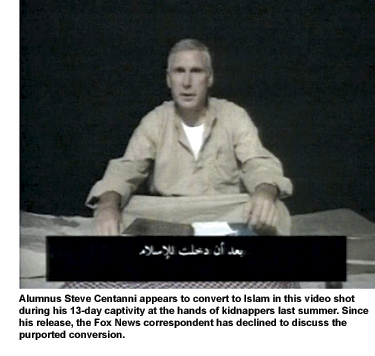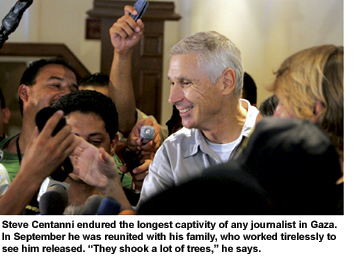| ||||
Dispatches from Danger Zones Overseas reporting can be a perilous profession. In the past, the challenge for journalists was, how do you get the story and images in time for the morning paper or the evening newscast? Today, the calculation is entirely different. Journalists must ask themselves, how do I get the story and stay alive? Daniel Pearl, The Wall Street Journal reporter beheaded in Pakistan, is the first person who comes to mind when talking about the dangers of working in conflict zones. But the toll is much higher. This year alone, 32 journalists have been killed because of their work, according to the New York-based Committee to Protect Journalists. Many more have been injured or kidnapped. "The rules of the game no longer apply," says longtime television journalist Marty Gonzalez, an associate professor in the Department of Broadcast and Electronic Communication Arts who reported from Central America during the war-torn 1980s. "It used to be that a media press credential carried some weight in foreign countries, the government or the guerrillas would recognize that you were an impartial observer. But that's not the case anymore. Journalists, especially those from the West, are seen as spies, or extensions of âthe great Satan,' or bargaining chips. It's much more dangerous now than at any other time." Assistant Professor Dina Ibrahim, who teaches broadcast journalism, warns students of hazards that may await them on the job. At the same time, the former CNN and BBC reporter is reluctant to discourage young people from going into a line of work that's so essential to a healthy democracy. "There are the questions, is the risk really worth it? How far are you really willing to go to get the story? On the other hand, without the willingness to take those risks, how informed can we really be?" Ibrahim says. Moreover, for many aspiring journalists, the idea of working in an unfamiliar and even treacherous environment is "part of the romance of journalism," says Professor Erna Smith, acting chair of the Journalism Department. No one need tell Steve Centanni (B.A., '77) and Lucian Read (B.A., '01) about the perils of working in a conflict zone. Centanni survived a kidnapping in Gaza last summer; Read faces daily danger as an embedded photographer in Iraq. Each has a cautionary tale for those who will follow in their footsteps. But the mounting perils of working in a war zone caught up with Centanni on a hot afternoon in Gaza last summer. The 60-year-old newsman and his New Zealand cameraman, Olaf Wiig, were driving down a narrow street when a truck blocked their path. Masked gunmen dragged the pair out of their SUV, pushed them onto the floor of the crew cab and sped away. This quiet American was suddenly the top story of the day. While Centanni's close-knit Italian-American family -- seven siblings living mostly on the West Coast -- waited anxiously, colleagues at the Jerusalem bureau of Fox News rushed to Gaza, where they joined forces with Wiig's wife, New Zealand broadcaster Anita McNaught. The group worked quietly yet desperately behind the scenes, meeting with members of Hamas, Fatah and anyone else who might be able to apply pressure on the kidnappers. "It was two weeks of hell," says Steve's brother Ken. "Not knowing and the fear of not knowing what was going to happen." Among those the group turned to for help was the Palestinian legislator Saeb Erekat (B.A., '75; M.A., '77), who studied at SF State at the same time as Centanni. Erekat helped arrange a meeting with Palestinian President Mahmoud Abbas, who pledged to do what he could. To keep up their spirits, Centanni and Wiig told themselves they were useless to their captors dead. Still, the 13-day experience was "the worst possible nightmare you could think of," Centanni says. Fear struck especially hard when the kidnappers prepared to make a video of their prisoners, calling to mind Pearl's taped execution. Aware that their families would be watching, Centanni and Wiig, seated cross-legged on the floor, spoke calmly into the camera, their voices betraying little of their desperate circumstances. In the early-morning hours of Aug. 23, the kidnappers woke Centanni and Wiig and told them, "You go home today." They drove the pair to a Gaza hotel and let them out of the car. Only later did Centanni learn that the captors had told Wiig privately that they intended to kill Centanni, whom they suspected of being a spy for the Americans. The kidnapping was the longest of any journalist in Gaza. Though he's lived in the Washington, D.C., area for a decade, Centanni remains a San Franciscan at heart. He was born in the city and raised in Los Altos. In 1966, Steve followed older brother Nicholas (B.A., '76) to SF State. Both siblings were interested in broadcasting, and the University's Radio-Television-Film Department was known as the best in Northern California. Centanni's first on-air gig was at a campus radio station with a signal so weak "you could only get it if you plugged in your toaster to the dormitory outlet." Forty years later, the newsman can still call into service his radio jock voice: "You've got KBRG, giant 88 at San Francisco State!" In the 1980s, Centanni broke into television at KRON-TV in San Francisco as a news writer. After eight years, he joined KTUU-TV in Anchorage, Alaska, as a reporter and producer. In 1996, Centanni landed a job at the newly established Fox network as a national correspondent based in Washington, D.C. Gaza was only the latest in a long string of assignments in conflict areas. Centanni reported the fall of the Taliban in Afghanistan and was an embedded reporter with Navy Seals during the invasion of Iraq. Overseas work suited Centanni's love of adventure and curiosity about other cultures, while the danger spots admittedly fed his appetite for "living on the edge, the chaos and excitement and the constant demands to be on your toes." The work has never been easy on his loved ones. "My family, my brothers and sisters, my good friends, some of them said, âWe understand why you're doing it, but we wish you wouldn't,'" Centanni says. "But as a journalist, when there's a war, you want to be there to tell the difficult stories, the stories of people whose lives are in danger." Centanni returned to work at Fox in October, still "a little embarrassed about being the story instead of reporting the story." He isn't ruling out another overseas assignment, but he has no immediate plans to return to Gaza, which he says is "now more chaotic and dangerous than it's ever been." Aspiring journalists, Centanni cautions, "need to realize that the world is a more dangerous place than it was." Read's photos came out first in Time magazine and were later picked up by other major magazines and newspapers. That's usually a cause for celebration in the life of a young photographer. But Read wishes the whole thing had never happened. The U.S. Navy is now investigating whether the Haditha killings amount to a war atrocity. Read doesn't know. On the day they happened, he had stayed back at the base to do laundry and relax. The bodies were two days dead when Read captured the images. The photographer was accompanying Marines on patrol when a group of Iraqis, noticing that he had a camera but no weapon, beckoned him inside a house where some of the bodies lay. None of the Marines, Read recalls, did anything to stop him from shooting the photos. Read is conflicted by the case, saddened by the killings but sensitive to the strains on young soldiers serving second, third and sometimes fourth tours of duty. "Do I think it's possible they did what they're accused of? Yes, because it's war. Do I think they're responsible? Responsibility goes in a lot of different directions and [it wouldn't be] just theirs," he says. The case still gnaws at Read. Some of the Marines implicated in the killings are his good friends. "If I had been there that day," he says ruefully, "it might never have happened in the first place." Read makes his home in Manhattan but he grew up in Austin, Texas. His father, Barry, now a judge in Southern California, showed him how to look at the world through a square formed by his fingers and thumbs. At 19, he came to San Francisco to study photography. His early work was artsy and conceptual. But studying under Professor Ken Kobre, Read learned about photojournalism and how to use his camera to tell stories. He is mostly fearless -- "brave but not stupid," is how his father puts it -- and good at living by his wits. In 2002, he went to Sarajevo looking for something interesting to photograph. Read spent 10 days with a group of Kosovar gypsies living inside a bomb-blasted building, taking photos that he later sold to MSNBC.com. The next year, he went to Bolivia to photograph coca growers and was temporarily detained by state security forces. In 2004, he photographed the armed rebellion that overthrew Haiti President Jean-Bertrand Aristide. Assistant Professor Yumi Wilson, with whom Read studied newswriting at SF State, isn't surprised at his globetrotting adventures. "That's where he always wants to be -- where the action is," she says. In mid-2004, Read went to Iraq with the 11th Marine Expeditionary Unit. He spent nine months there and has returned three more times. He spends most of his time there with Marines, shooting assignments for Newsweek, The New York Times and other publications. Read has seen heavy fighting twice, first in Najaf and then Fallujah, where an exploded mortar left bits of shrapnel in his shins. Read recalls being deathly afraid only once. His camera shorted out during a rainstorm in Fallujah. Unable to shoot photos, Read said he felt suddenly exposed and vulnerable. "That's when I started to think, this is really a bad place to be," he says. "Fortunately, there was another photographer there, and as soon as he put a camera in my hand, that feeling of anxiety just flew away." To view Lucian Read's photography, visit www.lucianread.com -- Anne Burke
| ||||











 Fox News correspondent Steve Centanni never expected to find himself at the center of a kidnapping drama. The journalist and Bay Area native has a low-key style and doesn't draw unnecessary attention to himself. Off the job, Centanni is intensely private, and is rarely recognized on the street. "I'm just a reporter who tells people what's going on," he says.
Fox News correspondent Steve Centanni never expected to find himself at the center of a kidnapping drama. The journalist and Bay Area native has a low-key style and doesn't draw unnecessary attention to himself. Off the job, Centanni is intensely private, and is rarely recognized on the street. "I'm just a reporter who tells people what's going on," he says. On Nov. 21, 2005, photographer Lucian Read shot images of Iraqi civilians killed by U.S. Marines in Haditha, an insurgent stronghold west of Baghdad. One of Read's photos is particularly haunting. Seven bodies wrapped in snow-white shrouds lie on a concrete floor, straight as mummies, arms crossed over chests. A small child is among the dead.
On Nov. 21, 2005, photographer Lucian Read shot images of Iraqi civilians killed by U.S. Marines in Haditha, an insurgent stronghold west of Baghdad. One of Read's photos is particularly haunting. Seven bodies wrapped in snow-white shrouds lie on a concrete floor, straight as mummies, arms crossed over chests. A small child is among the dead.